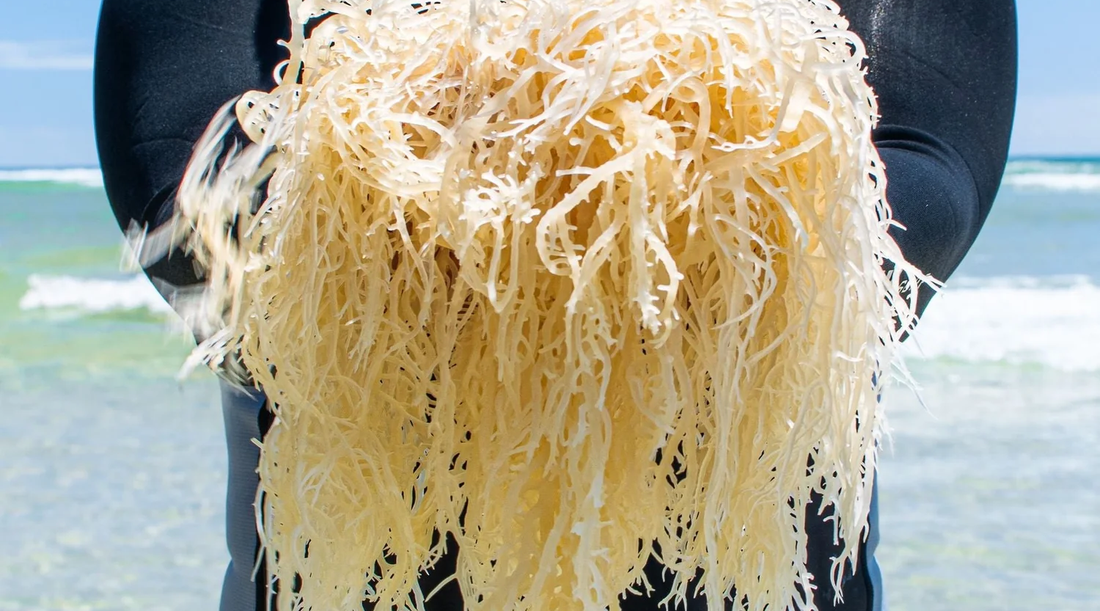Everything You Need to Know About Sea Moss: Nature’s Most Nutrient Dense Powerhouse
According to archaeologists, Sea Moss, specifically Chondrus Crispus (Irish Moss), has been used for its powerful healing benefits for approximately 14,000 years dating back to 600 BC.
Sea Moss was especially crucial during the Irish Potato Famine in the 1800s when people needed to supplement vital nutrients to survive. Back then, the Irish believed this naturally growing algae would cure sick calves, human colds & flus, and congestion.
Today, Sea Moss is still being enjoyed worldwide for its nutritional benefits and natural properties that nourish the body and mind.
What is Sea Moss?
Sea Moss is a sea vegetable that comes in Gold, Purple, Green and Red varieties. Due to its wide range of health benefits, Sea Moss is primarily used by humans as a natural supplement.
Found in both, tropical and colder oceans, Sea Moss is an edible sea plant and can be likened to other one’s humans consume like seaweed, algae and other leafy vegetables such as kelp. Sea Moss is an algae but actually looks a lot more like seaweed.
Each variety is potent, pure and reported to contain a multitude of essential vitamins, minerals and amino acids our bodies need to function at optimal levels, including vitamin A, B, C, E and minerals like Iron, Magnesium, Manganese, Zinc, Selenium, Potassium, Iodine and Calcium to name a few.
There are three main types of Sea Moss species: Eucheuma Cottonii, Gracilaria, and Chondrus Crispus (Irish Moss), all of which are closely related with similar benefits but slightly different tastes.
We find that the darker the moss, the stronger the flavour is.
Sea Moss Nutrition
Sea moss is one of the most nutrient-dense foods on the planet, and is a rich source of many vitamins, minerals, polyunsaturated fats and anti-inflammatory compounds.
Nutritionally, sea moss is low in calories and sugar, and contains a small amount of protein. Like other seaweeds, it’s low in fat, but it is polyunsaturated fat, which is a nutritious type of healthy fat that may help reduce cholesterol levels.
A small serving of 2 tablespoons (10 grams) of sea moss typically has:
The iron and magnesium content in sea moss is what really stands out. Just 28g of sea moss contains 14% of the daily value of iron, an essential mineral required for healthy red blood cells. And 28g provides 10% of the daily value for magnesium, a mineral involved in over 300 biochemical reactions in the body.
Why is Sea Moss good for you?
Sea Moss is widely known for its multitude of health benefits as it is rich in many vitamins and minerals that our bodies need to stay healthy.
It’s been reported all over the world that Sea Moss contains 92 out of the 102 minerals the human body needs. The Top 10 Minerals that Sea Moss contains include:
- Iron
- Zinc
- Magnesium
- Manganese
- Calcium
- Iodine
- Sodium
- Phosphorus
- Selenium
- Boron
Sea Moss also contains Vitamins like B Vitamins, A, C, D and E. Plus, an abundance of other trace minerals that together, work to maintain a healthy lifestyle.
Weight Loss
Many people begin incorporating Sea Moss into their daily diet as it may contain properties that can help aid in weight loss. Although it can’t be labelled as a direct, standalone way of losing weight, Sea Moss contains multiple properties that may aid in:
- Regulating your appetite
- Influencing your fat metabolism
- Modulating your guts good bacteria
Sea Moss may help regulate your appetite by helping increase your feeling of fullness when eating. This is primarily because of the naturally occurring carrageenan that seamoss contains.
The 102 Minerals our Body needs for optimal Health!
The Human body is amazing and capable of absorbing all the Minerals and Vitamins that it needs to strive.
Due to our busy lives we often find ourselves not being able to provide our bodies all the needed minerals and vitamins; supplementing with nutrient dense superfoods is the perfect way to support our mind and body.
|
1. Actinium 2. Aluminium 3. Americium 4. Antimony 5. Argon 6. Arsenic 7. Astatine 8. Barium 9. Berkelium 10. Beryllium 11. Bismuth 12. Bohrium 13. Boron 14. Bromine 15. Cadmium 16. Caesium 17. Calcium 18. Californium 19. Carbon 20. Cerium 21. Chlorine 22. Chromium 23. Cobalt 24. Copper 25. Curium 26. Dubnium |
27. Dysprosium 28. Einsteinium 29. Erbium 30. Europium 31. Fermium 32. Fluorine 33. Francium 34. Gadolinium 35. Gallium 36. Germanium 37. Gold 38. Hafnium 39. Hassium 40. Helium 41. Holmium 42. Hydrogen 43. Indium 44. Iodine 45. Iridium 46. Iron 47. Krypton 48. Lanthanum 49. Lead 50. Lithium 51. Lutetium 52. Magnesium |
53. Manganese 54. Mercury 55. Molybdenum 56. Neodymium 57. Neon 58. Neptunium 59. Nickel 60.Niobium 61. Nitrogen 62. Osmium 63. Palladium 64. Phosphorous 65. Platinium 66. Plutonium 67. Polonium 68. Potassium 69. Praseodymium 70. Promethium 71. Protactinium 72. Radium 73. Radon 74. Rhenium 75. Rhodium 76. Rubidium 77. Ruthenium 78. Samarium |
79. Scandium 80. Selenium 81. Silicon 82. Silver 83. Sodium 84. Strontium 85. Sulphur 86. Tantalum 87. Technetium 88. Tellurium 89. Terbium 90. Thallium 91. Thorium 92. Thulium 93. Tin 94. Titanium 95. Tungsten 96. Uranium 97. Vanadium 98. Xenon 99. Ytterbium 100. Yttrium 101. Zinc 102. Zirconium
|
How Do I Use Sea Moss?
Sea Moss is super easy and delicious to consume!
The gels are extremely versatile and you can use it in the following forms.
- Straight off the spoon: our favourite way
- Drink Sea Moss Gel daily and mix it with water or juice
- Blend in smoothies: makes them thicker and creamier
- For breakfast to boost the nutritional content; in yoghurt, cereal or with fruit salad
- Raw Desserts; acts as a natural plant-based gelatine
- In dips, like guacamole and hummus
- Made in ice cubes for drinks or ice blocks for kids







